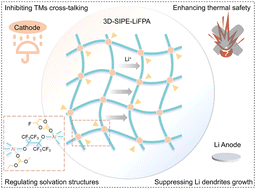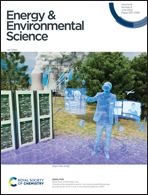In situ-polymerized lithium salt as a polymer electrolyte for high-safety lithium metal batteries†
Abstract
Polymer electrolytes offer advantages of leak-proofing, excellent flexibility, and high compatibility with lithium metal, enabling the highly safe operation of lithium metal batteries (LMBs). However, most current polymer electrolytes do not meet the requirements for the practical applications of LMBs. Herein, to resolve this issue, employing thermal-induced in situ polymerization of lithium perfluoropinacolatoaluminate (LiFPA), we present a novel interface-compatible and safe single-ion conductive 3D polymer electrolyte (3D-SIPE-LiFPA). It is demonstrated that 3D-SIPE-LiFPA with a unique polyanion structure promoted the formation of a protective electrode/electrolyte interface and inhibited the dissolution–migration–deposition of transition metals (TMs). 3D-SIPE-LiFPA endowed LiNi0.8Co0.1Mn0.1O2 (NCM811, 3.7 mA h cm−2)/Li (50 μm) LMBs with a long cycle life at both the coin-cell level (80.8% after 236 cycles) and pouch-cell level (437 W h kg−1, 95.4% after 60 cycles, injected electrolyte 2 g A h−1). More importantly, pouch-type NCM811/Li LMBs using 3D-SIPE-LiFPA delivered significantly enhanced onset temperature for heat release (Tonset) and thermal runaway temperature (Ttr) by 34 °C and 72 °C, respectively. Our strategy of polymerizing lithium salt as a polymer electrolyte opens up a new frontier to simultaneously enhance the cycle life and safety of LMBs.



 Please wait while we load your content...
Please wait while we load your content...